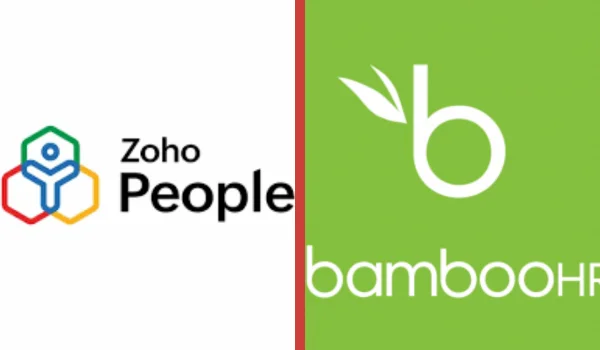Businesses are increasingly relying on Human Resource Management Systems (HRMS) to streamline HR operations, ensure compliance, improve employee experience, and boost productivity. Among the most popular HRMS solutions globally are Zoho People and BambooHR. Both platforms offer robust features tailored to small and medium-sized businesses, but which one provides more value in 2025? This comparison will help HR professionals and business owners make an informed decision.
✅ Overview of Zoho People
Zoho People is a cloud-based HR software developed by Zoho Corporation, part of a broader suite of business apps. It is known for its affordability, flexibility, and deep integration with other Zoho apps and third-party tools.
Key Features:
- Employee database and self-service portal
- Leave and attendance management
- Time tracking and project timesheets
- Performance management system
- Workflow automation
- Custom forms and fields
- Integration with Zoho CRM, G Suite, Slack, and more
✅ Overview of BambooHR
BambooHR is a dedicated HR software designed primarily for small to mid-sized businesses. It focuses on intuitive design, streamlined onboarding, and advanced people analytics.
Key Features:
- Centralized employee records
- Time-off tracking
- Applicant Tracking System (ATS)
- Onboarding and offboarding workflows
- Performance management
- eSignature and document storage
- Reporting and analytics
🔍 Feature-by-Feature Comparison

| Feature | Zoho People | BambooHR |
| Core HR Functions | Comprehensive and highly customizable | User-friendly and well-organized |
| Recruitment Tools | Basic recruitment add-ons | Built-in ATS with excellent UX |
| Onboarding | Workflow-based, flexible onboarding | Intuitive, automated onboarding tools |
| Performance Management | Custom review cycles, 360° feedback | Goal setting, peer feedback, reviews |
| Time Tracking | Robust with project-based tracking | Available as an add-on |
| Mobile App | Android & iOS; well-rated | Clean, responsive app experience |
| Integrations | Zoho ecosystem, G Suite, Zapier, more | QuickBooks, Slack, Google, MS Teams |
| Customization | High—custom fields, forms, workflows | Moderate—focused on simplicity |
| Pricing (2025) | Starts at ₹60/user/month | Starts at $6–$8/user/month |
| Free Trial | 30 days | 7 days |
💰 Pricing and Affordability
Zoho People continues to lead in terms of affordability. With pricing starting around ₹60 per user/month (Essential HR plan), it is highly cost-effective, especially for Indian businesses or startups with tight budgets. Zoho also offers multiple pricing tiers, including a free plan for up to 5 users, making it ideal for very small teams.
BambooHR, on the other hand, does not publicly list exact pricing. It typically starts at $6–$8/user/month, with costs increasing based on modules like ATS or Time Tracking. For Indian companies, currency conversion makes BambooHR significantly more expensive.
🌍 User Experience and Interface
BambooHR is known for its clean and modern UI. It’s easy to navigate and beginner-friendly, especially for HR teams with limited technical skills. It places a strong focus on employee engagement with features like self-assessments and quick feedback.
Zoho People offers a highly customizable interface, but the sheer number of options may be overwhelming for first-time users. However, once configured, it offers excellent workflow automation and personalization that BambooHR lacks.
🌟 Integration Ecosystem
Zoho People integrates naturally within the Zoho ecosystem, which is a huge plus for companies already using tools like Zoho CRM, Zoho Books, or Zoho Projects. Additionally, it supports third-party integrations through Zapier, Microsoft 365, and Google Workspace.
BambooHR offers integrations with various third-party applications such as QuickBooks, Slack, and Xero, and also supports open API access. However, it lacks the deeply embedded suite-style integration that Zoho offers within its ecosystem.
✅ Pros and Cons
Zoho People
Pros:
- Affordable and scalable
- Deep customization and workflow automation
- Strong time tracking and attendance tools
- Part of Zoho’s broader business suite
Cons:
- Learning curve for new users
- ATS is not built-in
BambooHR
Pros:
- Excellent user interface and ease of use
- Built-in ATS and onboarding workflows
- Great support and user community
Cons:
- Expensive, especially outside the US
- Fewer customization options
- Some features (like time tracking) are add-ons
🏆 Verdict: Which Offers More Value in 2025?
In 2025, the choice between Zoho People and BambooHR largely depends on your business needs and budget.
- If you are a startup, small business, or growing company in India (or on a budget): Zoho People offers more value. Its affordability, customization, and strong features in time tracking and leave management make it an ideal HRMS platform.
- If your priority is ease of use, built-in recruitment, and polished UI: BambooHR may be worth the higher price, especially for businesses focused on talent acquisition and employee experience.
Final Thought:
Zoho People provides greater overall value for money, especially in cost-sensitive markets like India, whereas BambooHR shines in user-friendliness and built-in recruitment capabilities. Businesses must weigh their feature priorities and budget constraints to make the right choice in 2025.

Hi, I am Kapil Kumar, founder and chief editor of indiasvibes.com, a platform delivering the latest updates on business, finance, entertainment, and sports. With a passion for insightful storytelling, I am and my team ensures our readers receive accurate and engaging content.

